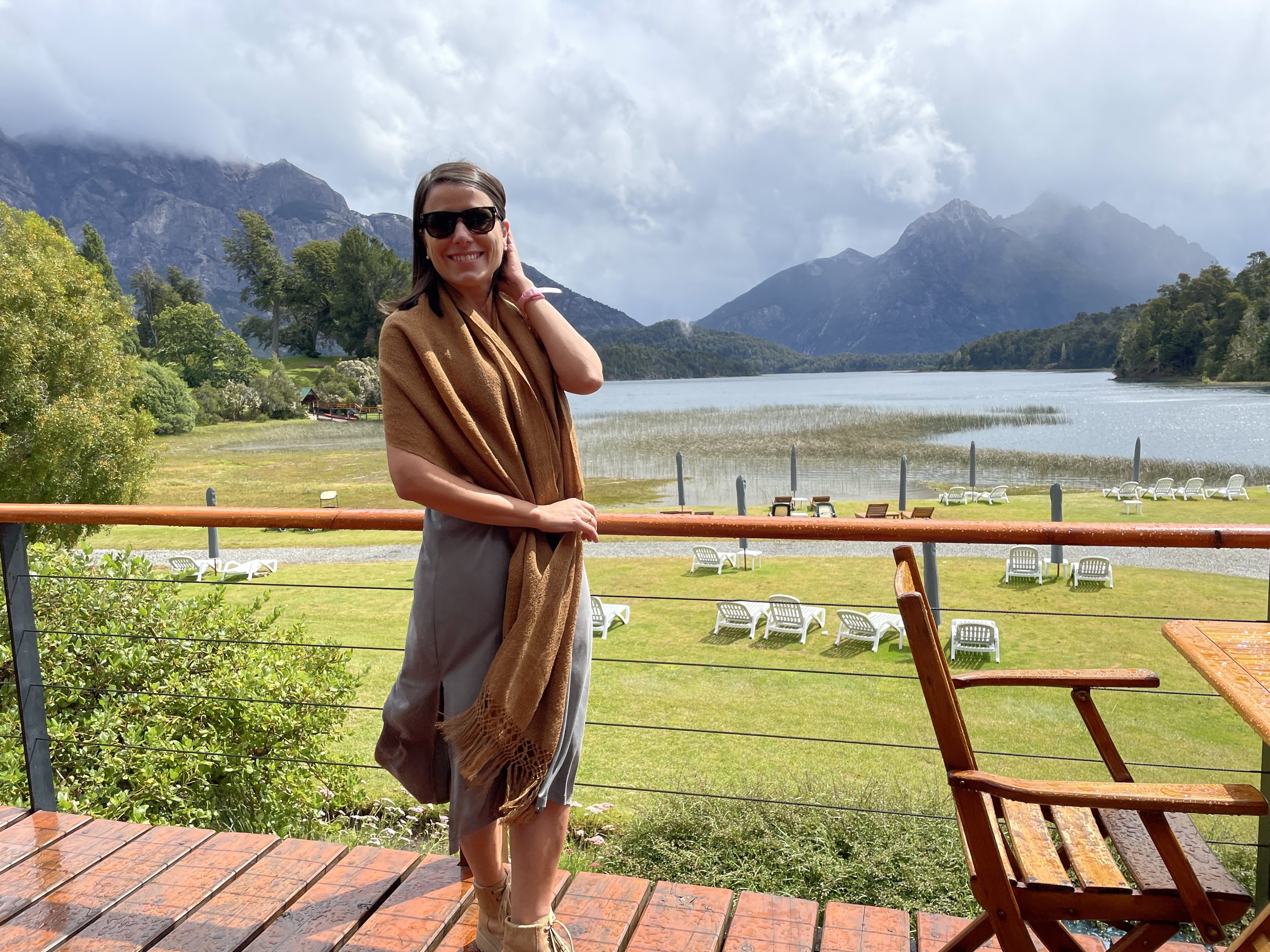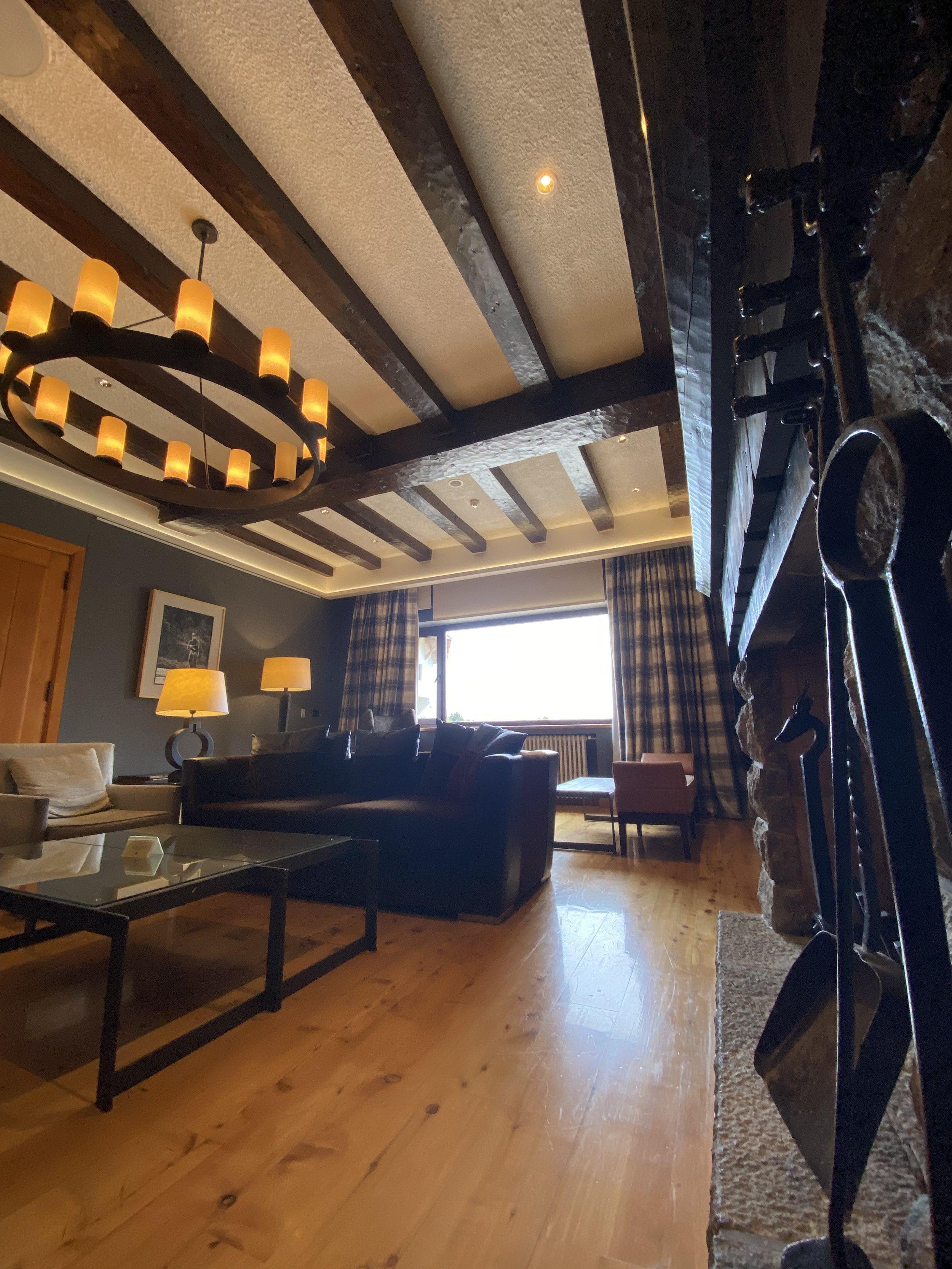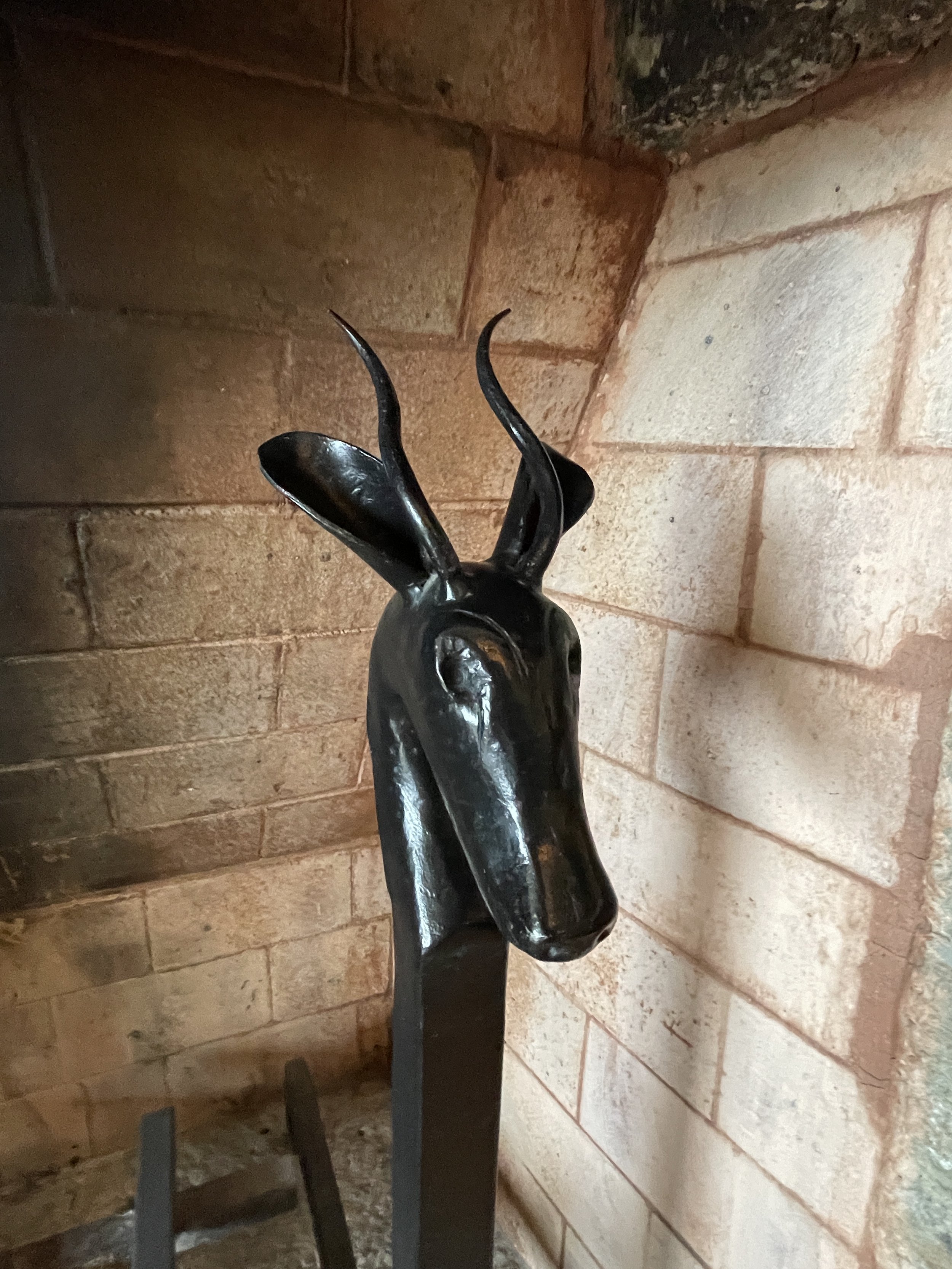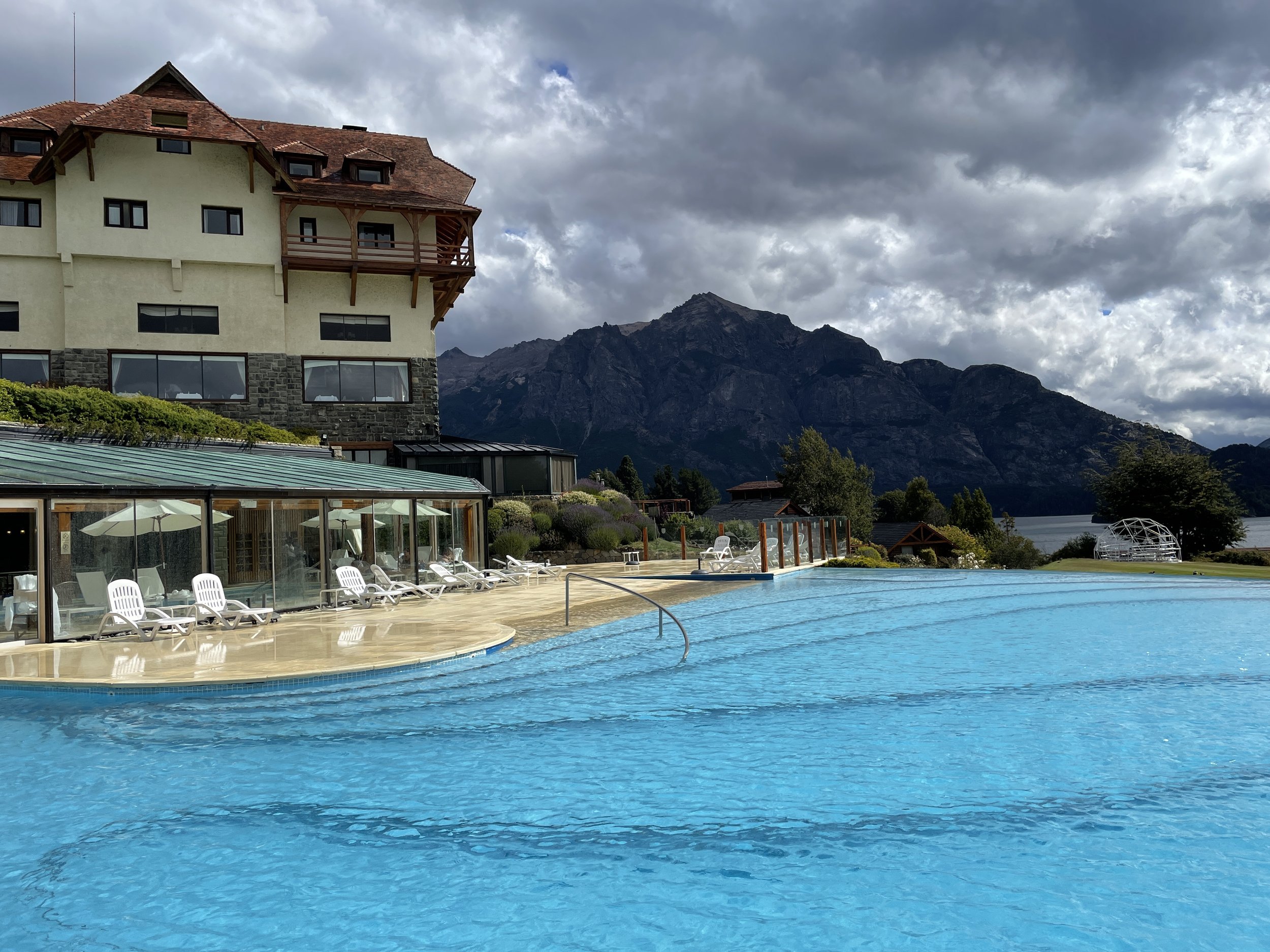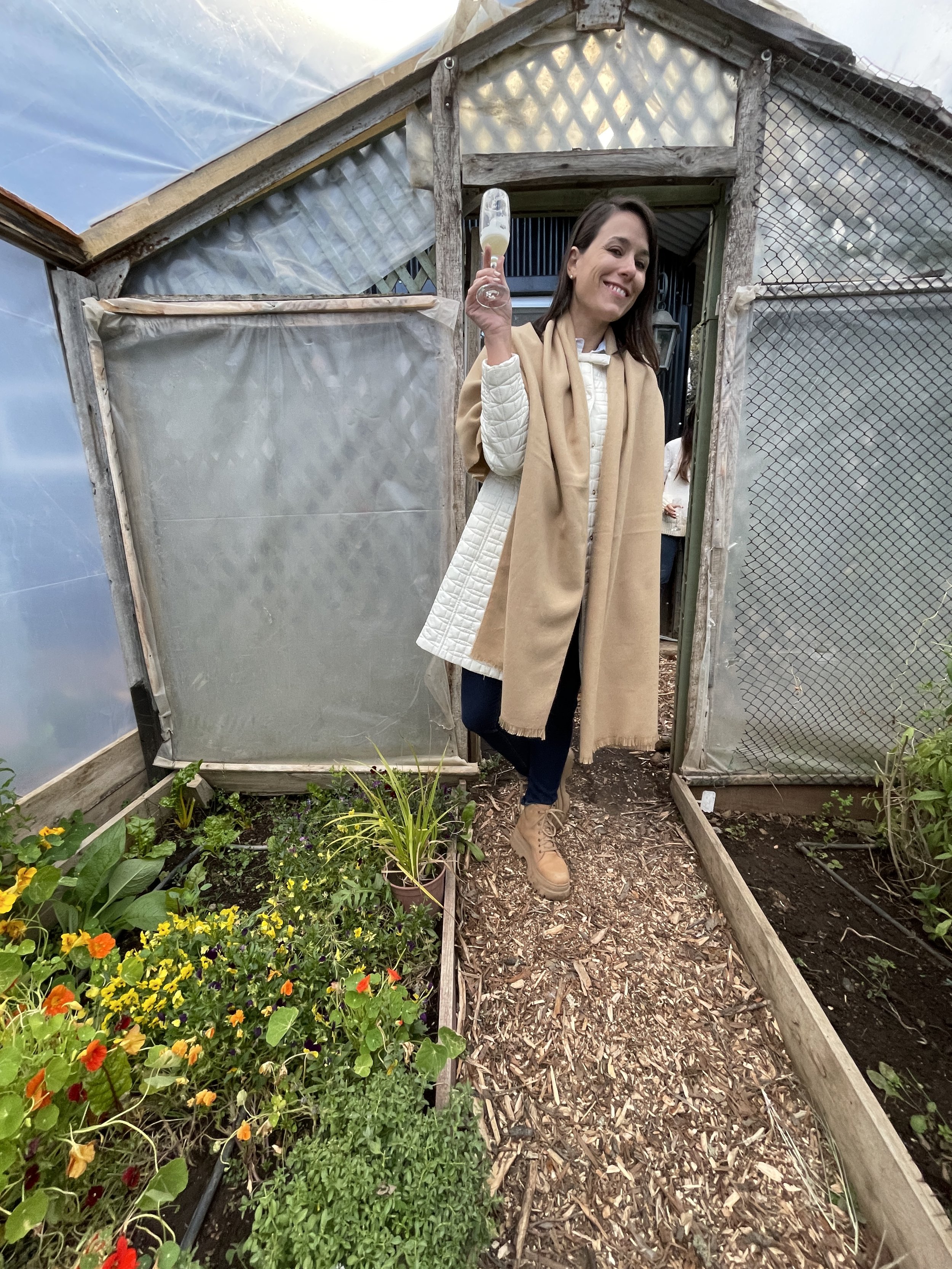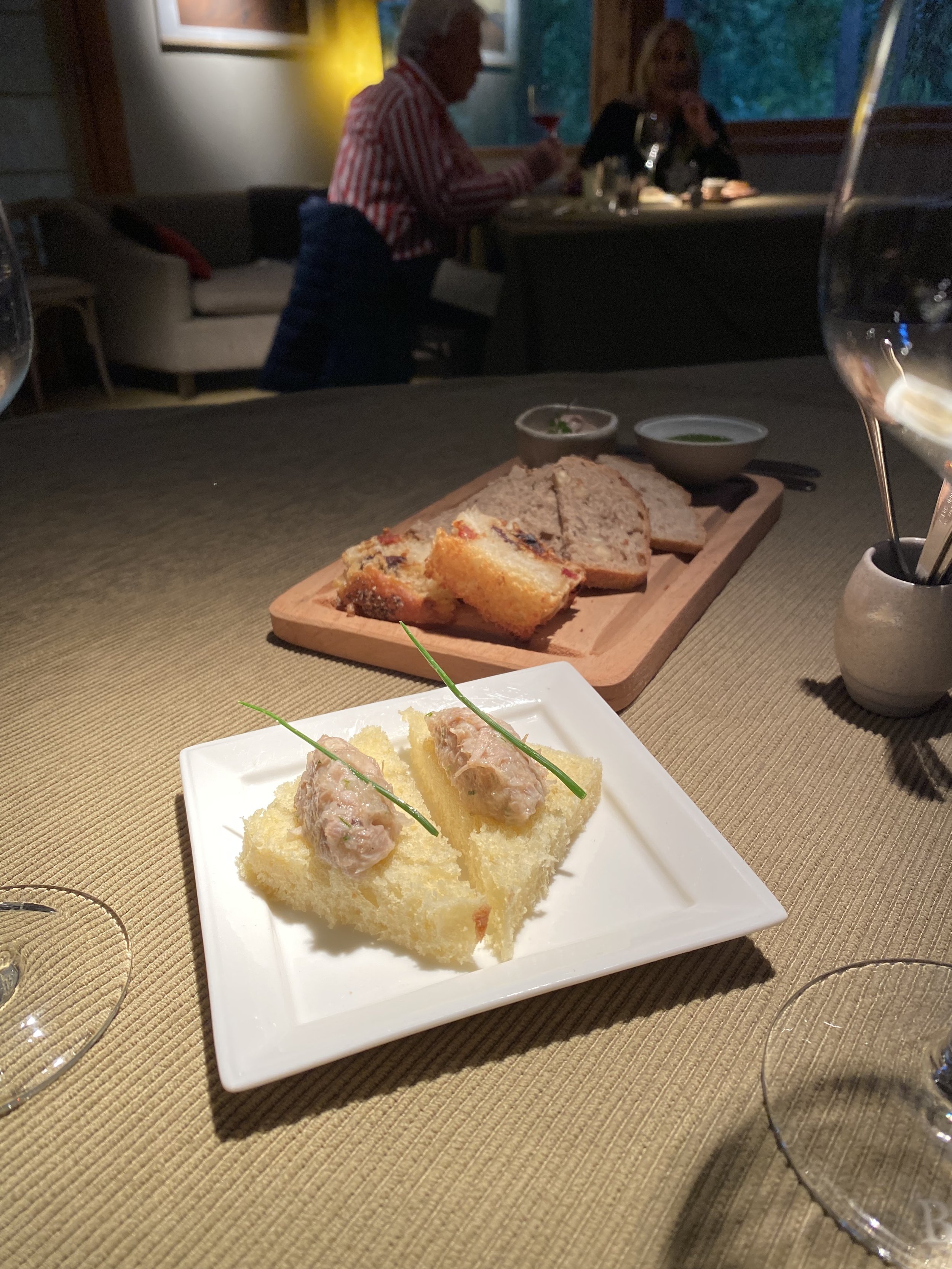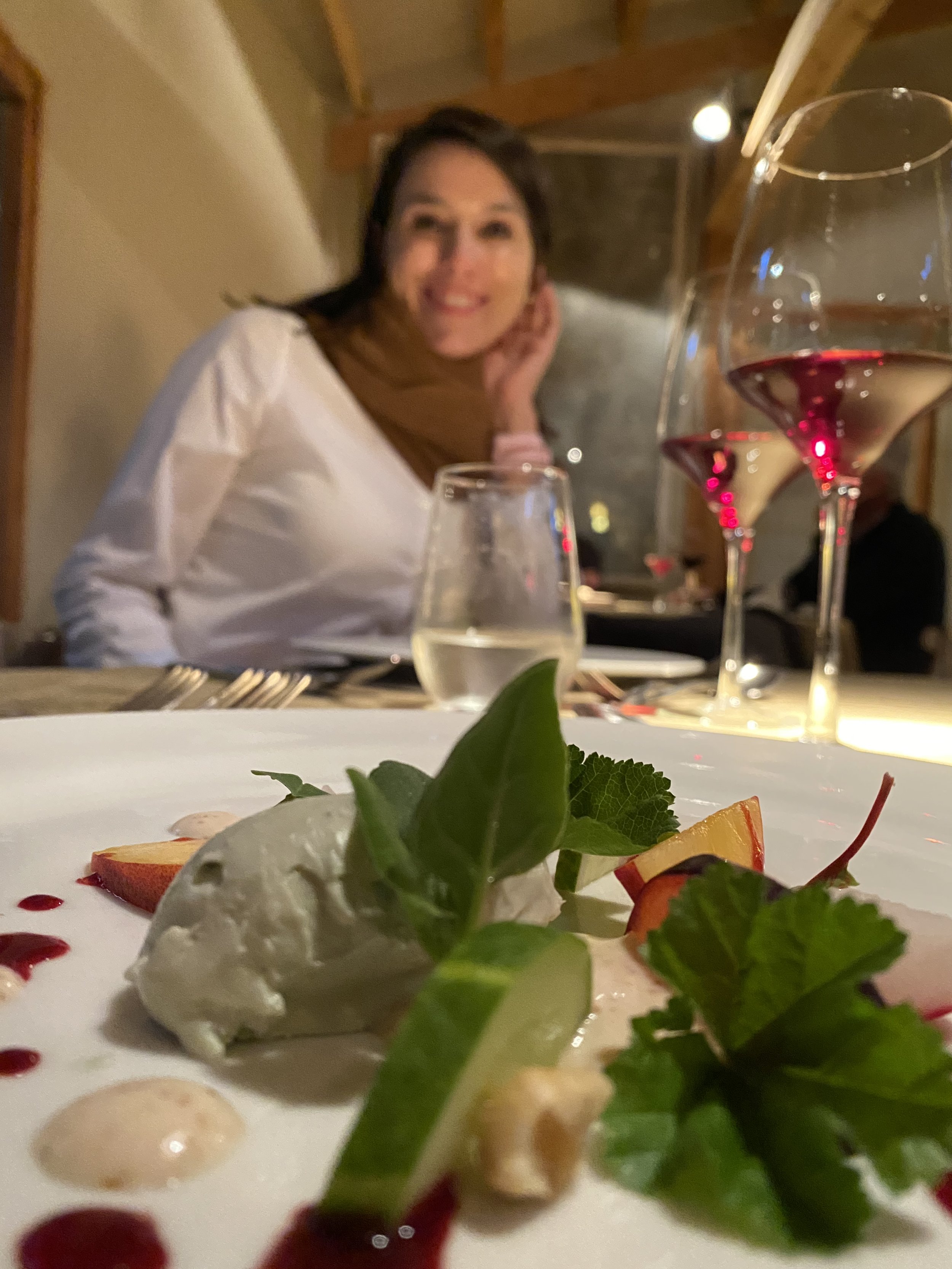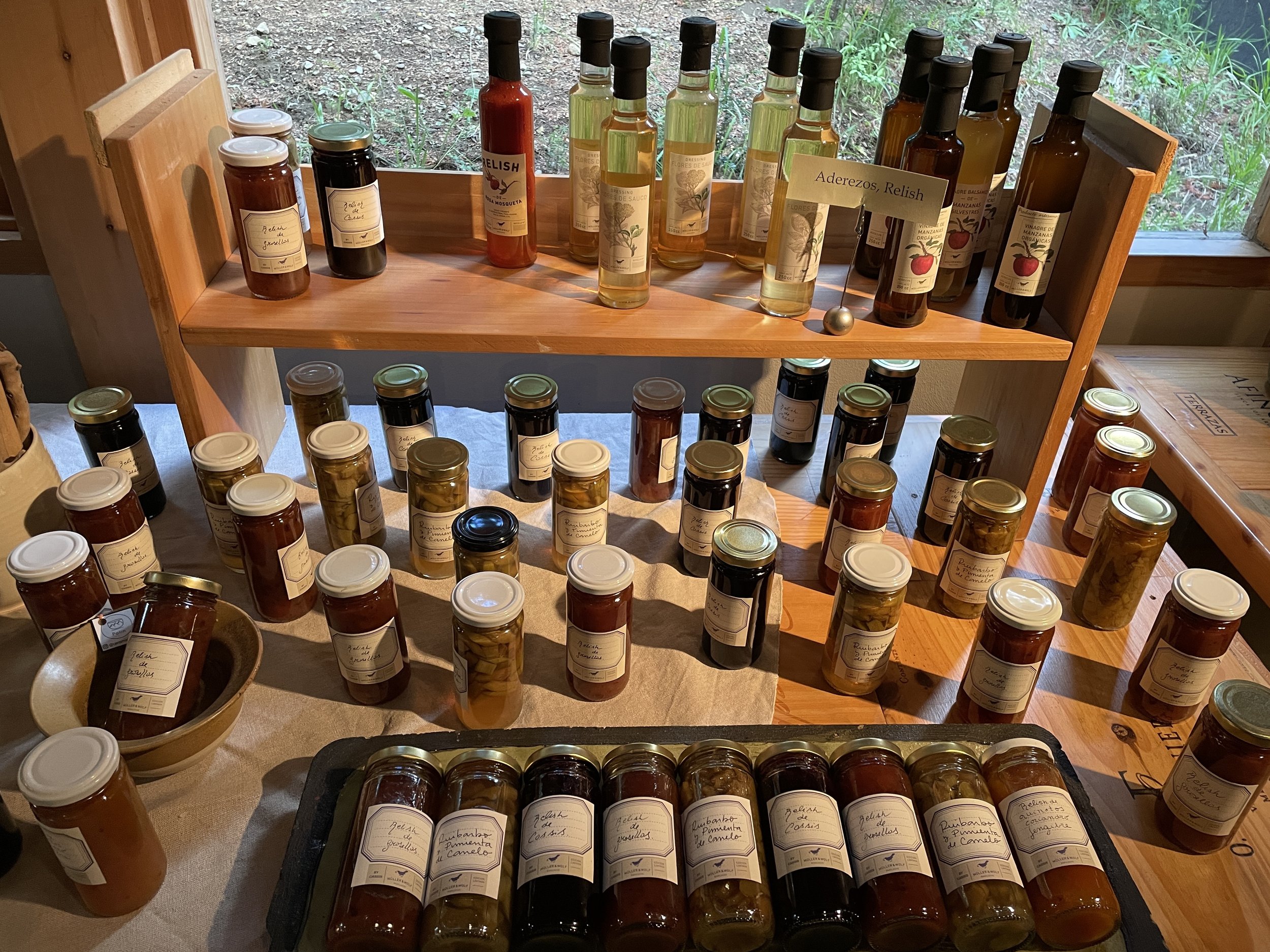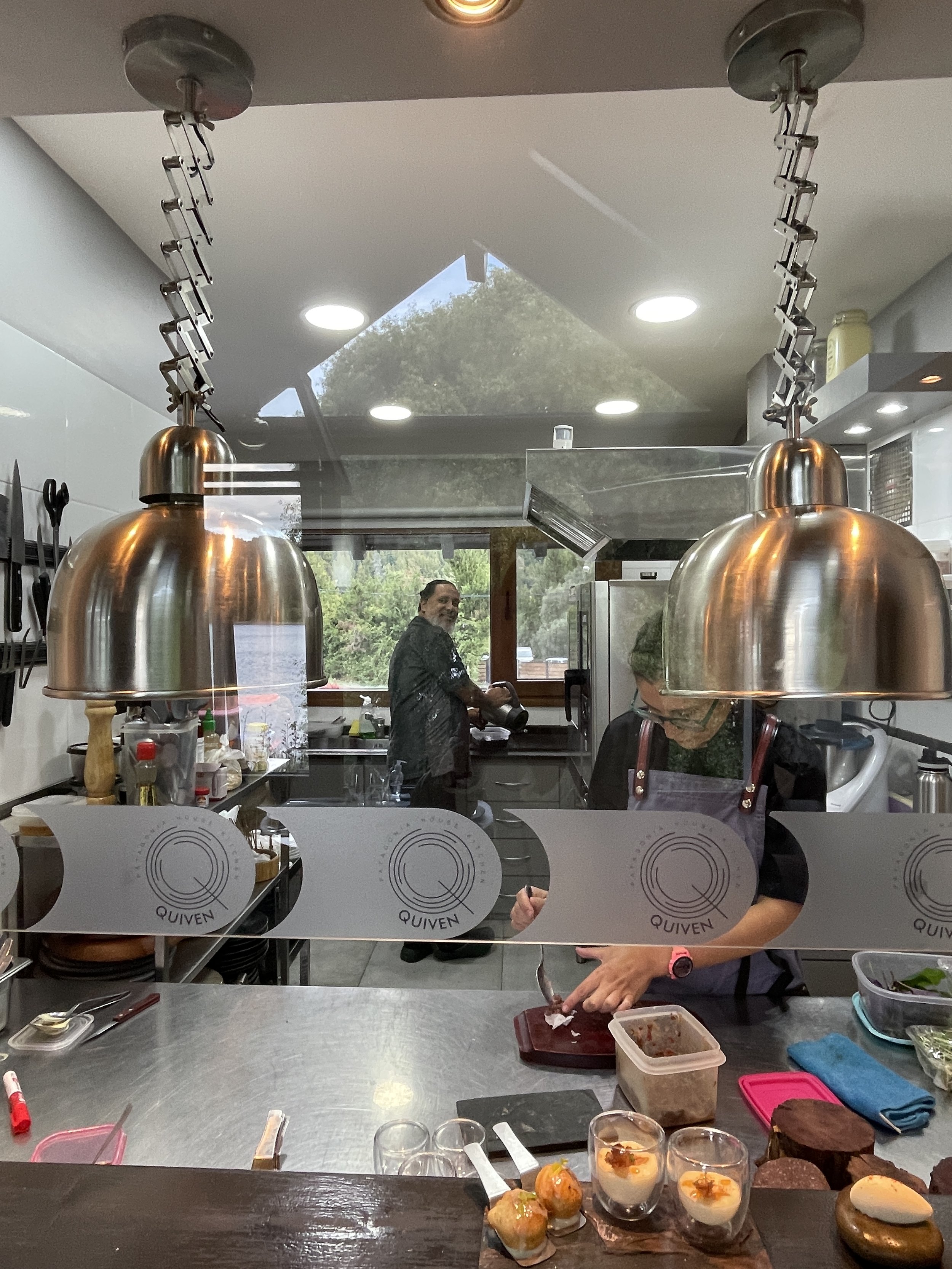Bariloche gourmet
Gastronomic and relax tourWhen we arrived in Bariloche we knew we had to try the experience of having tea in one of the many houses that offer this service. We were lucky enough to book a table for two on the terrace of Casa Meiling, a family bakery with a nice view of Lake Nahuel Huapi, although it is worth mentioning that there is a steep climb to get there. If you don't have a car, calories will be burned before and after. Almost everything in Bariloche is actually uphill or downhill.
The three-story tower included sweet bites, cream cakes, classic scones with cream cheese and jam and, of course, sandwiches with generous fillings.
It can be said that Meiling is not looking for a commercial atmosphere but a family one, which is demonstrated by the personalized attention of its owner and by the romantic saxophone music, perhaps rather old-fashioned... but in this case it adds to the relaxed atmosphere, almost as if we were guests and not customers.
The variety of cake options served is ideal and the taste is homemade and authentic, highly recommended!
As for the classic chocolates of southern Argentina, in our case there was no doubt: the chosen ones were the giant and famous Rapanui and Mamuschka stores. There are other local options, more artisanal of course, but those two brands, along with Chocolates Del Turista, are the most recognized nationally.
Visiting these stores at peak times is a hassle, whether to buy their products or to enjoy the lunches and teas served in their lounges. A world of tourists coming and going, not knowing what they want, noisy and clumsy, make up the scene. We resist all the hustle and bustle and manage to get the respective pound of assorted Patagonian chocolate promised to our families. At the Russian doll store we also bought some coffee beans with a touch of caramel.
The morning after the only night we stayed in downtown Bariloche, we returned to the stores in the hope of enjoying an infusion... but even when they opened, they were already saturated with tourists. So, if you want to make a purchase, be patient, buy a small box and run away at full speed.
For dinner, there are gastronomic options of the Seven Lakes that are of the highest international level.
We have decided to stay at Llao Llao, hotel, an Argentine classic that we wanted to visit.
Its emblematic building, designed by Alejandro Gabriel Bustillo, has stately halls, carpeted corridors, wood-paneled walls and breathtaking views.
However, we were not pleased. Perhaps the crowds overshadowed its glamour; perhaps the concept of massive lodging with hundreds of rooms; perhaps the deer and stuffed deer hanging from its walls generated an effect contrary to its time; perhaps the lack of personalized attention; or perhaps a mixture of all of the above meant that beyond breakfast we did not try its varied gastronomic options, nor its famous tea service in the Winter Garden. As it happens, the pastries, croissants and muffins offered at breakfast were really a disappointment. The orange juice was not even freshly squeezed, although once again the view from that dining room was fascinating. We'll take it! And also with the good Spritz from the Espacio Lago Moreno lounge.
None of their lounges or bars considered an adults-only space, so at all hours there were naughty children playing around the tables. Something illogical considering that the hotel offers a Kids Room.
Our stay at the Llao Llao Llao, far from moving us, left us with the definite lesson to look for smaller hotels, more focused on true relaxation and with more personalized attention.
At least the gray, rainy and cold days we had allowed us to enjoy in peace its two swimming pools, indoor and outdoor. For some reason the average tourist does not find it motivating to go swimming on a cloudy day, even if they are heated as is the case of the Llao Llao Llao.
It should be noted that the place offers the most varied attractions: golf, archery, hiking, spa, restaurants, stores, recreational activities. The elegance that defined it is maintained and probably still boasts the best views of Bariloche, whether to the mountains, the Nahuel Huapi or the beautiful Moreno Lake.
We were glad to have looked for other dining options outside the five-star hotel. Bariloche had great culinary surprises in store for us.
For starters, Casa Cassis. Almost a month before the trip we tried to reserve a table, without success. We were so fortunate that a couple of days before, two places were released and a message graced us with that longed-for table.
In front of Lake Gutiérrez, Ernesto Wolf and Mariana Müller created a small universe of plants, flowers, fruits and vegetables that give life to their very high cuisine.
The experience begins at eight o'clock sharp, usually in the garden next to the orchard, where appetizers and a welcome drink are served.
That summer evening was a little cool, so the itinerary was modified and began with a tour of the gardens and the orchard, visiting the cellar where their memorable vinegars and dressings are manufactured, and then, once in the cozy dining room, we settled in to taste the delicacies prepared by Mariana, la "China" for everyone.
During the tour of the garden, Ernesto makes an effort to transmit the search that he and his family have been doing for years to obtain aromatic herbs, flowers, red fruits and organic vegetables of the highest quality.
We were lucky enough to exchange a few words during this tour with Lucía, Sebastián and Gustavo, three charming from the capital with whom we ended up sharing the evening. The fortune of @tripticity_ -once again- was confirmed. It turns out that they were friends of the hosts, what a privilege!
Although the tables are arranged as in a traditional restaurant, the atmosphere of Casa Cassis is precisely that, that of a house, so it is easy to generate this interaction between the dozen diners.
We started with a few small appetizers, accompanied by sourdough breads with seeds and pâté.
The sequence?
First, the appetizers: elderflower sparkling wine; Cassis artisan wine cordial; rabbit confit rilette, daikon and dill; trucha tartare, yellow beets, chives flowers; poultry terrine with quince chutney; cold green leaf and herb soup and olive and tomato bread with wild rucoleta.
Then: summer crudité, blue cheese, hazelnuts, plum and mustard dressing; warm prawns, zucchinis, wild sprouts, cedron aromas; salmon trout, peas, broad beans, sparkling wine and peperina reduction; venison loin, borage, Manso morels, croûte and peppers.
Next, a granita of green currant wine prepared our palate for the light dessert: citrus sorbet, spice cake and creme cheese with yellow raspberries.
To conclude, an herbal infusion and petit fours.
We paired this experience with a pinot noir made by Matías Michelini, under the new technique of storage in concrete eggs.
The eight steps of the proposal were one better than the other. A delight almost from another planet, one of those flavors that are difficult to find and even more difficult to describe. The evening passed quickly, much more quickly than we would have liked. Fortunately for us, when our neighbors were Lucia, Sopa and Perro, so we were invited to their table for a memorable final toast, where we were able to talk with the creators of Casa Cassis. We felt blessed by fate, which rewarded us with a tremendous after-dinner conversation with five extraordinary people.
Before leaving, we were tempted by the options Cassis has for sale. We chose an elderflower nectar, a cassis sweet, a flower dressing, a Patagonian cheese and even a solid handmade shampoo, sure that all of them would honor the kilometers of our road trip.
And there was more. The following night, another superb banquet awaited us at the hands of Pablo Quiven, who elaborated a proposal -this time- of nine steps, which required us to fast for long hours before arriving at his kitchen house. Indeed, this is a contemporary concept that is becoming more and more in vogue in our country, in which the chef opens the doors of his home.
His place could not be more refined, with a beautiful view and a superlative decoration. The tables are arranged in a very pleasant environment.
Again, it would be impossible to put into words the enjoyment we experienced at Quiven. As any explanation, the delicacies of that night are described below.
First: black pudding bonbon dipped in tempura with white chocolate and cream cheese emulsion; gyozas stuffed with vegetables and dipped in teriyaki sauce; venison tartare with sweet pickle vinaigrette; potato emulsion in siphon with fried egg, crispy garlic and wild boar ham; cheese lollipop; smoked butter with ashes and artisanal sourdough breads with curry, beet or cocoa.
Second: avocado spiral seasoned with pickled vegetables and crispy sweet potato, quinoa and corn, plus confit tomatoes and different coulis.
Third: kale bathed in beer tempura with a trout tiradito seasoned with parmesan cheese and tiger's milk, red bell pepper caviar, trout crackling skin with cucumber and avocado gel.
Fourth: prawn bonbon with trout mousseline and brie cheese, crustacean foam and corn cream.
Fifth: smoked Japanese eggplant stuffed with cheese.
Sixth: egg cooked at 63°, with truffled potatoes, wild mushroom ragout, crispy parmesan cheese and pesto.
Main course: smoked wrapped beef tenderloin, grilled with sage butter and cooked sous vide at 53°, roasted pumpkin foam, paprika and tandoori sponge, caramelized roasted beets and broccoli flan with Roquefort cheese and criolla made with fruits from the Alto Valle.
Desserts: the "emblematic" tangerine cheese cake with cocoa soil on the one hand and, on the other, deconstruction of Patagonian forest with flavors characteristic of Bariloche: chocolate, red fruits, cocoa soil with different herbs, peach gel, lavender gel, pine gel, plus the house Greek yogurt with grated fruit, all accompanied by lavender ice cream.
Should anything be added? On Pablo's website the restaurant is advertised and described as "a journey to your senses" and that's what it really is - mind-blowing!
At the end of the meal, the chef himself comes over to greet his guests, showing a kindness on a par with his excellent dishes.
We did not have enough days to visit Quetro Cocina, another pending for a next trip to the South if destiny so disposes.
Anyway, we continued our journey satisfied to have met such interesting people and taking with us a conclusion: after Covid, the tourist-gastronomic industry has undergone radical changes and everything seems to be oriented today to human contact in the first person. And in this search for quality, San Carlos de Bariloche and its neighbor Villa La Angostura constitute the culinary axis of the Lake District. For the foodie who can indulge in a three or four-night stay, they represent an unavoidable destination.

